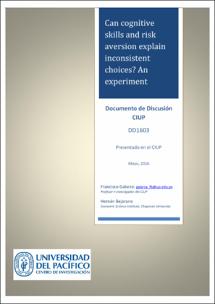| dc.contributor.author | Galarza, Francisco | |
| dc.contributor.author | Bejarano, Hernán | |
| dc.date.accessioned | 2016-07-21T15:42:36Z | |
| dc.date.available | 2016-07-21T15:42:36Z | |
| dc.date.issued | 2016-05 | |
| dc.identifier.uri | http://hdl.handle.net/11354/1132 | |
| dc.identifier.citation | Galarza, F., & Bejarano, H. (2016). Can cognitive skills and risk aversion explain inconsistent choices?: an experiment. Lima: Universidad del Pacífico, Centro de Investigación. Recuperado de http://hdl.handle.net/11354/1132 | es_PE |
| dc.description.abstract | Estudia la coherencia de las preferencias de riesgo entre universitarios en un país en vías de desarrollo. El diseño permite obtener la coherencia a nivel individual, en el que cada sujeto selecciona sus opciones preferidas de dos diferentes, pero relacionadas tareas de obtención de riesgo. En la primera tarea, los sujetos eligen una opción entre seis alternativas, descartando así la inconsistencia. La segunda tarea, es una transformación de la primera, que está destinada a examinar si la elección en la primera tarea también se revela como preferida. Al usar estas opciones, se construye medidas de preferencias incoherentes y analiza su correlación con las habilidades cognitivas (medido según Frederick (2005) en Cognitive Reflection Test—CRT scores and students’ GPAs) y las preferencias de riesgo. Se encontró que una puntuación CRT baja y un pobre rendimiento académico son, generalmente buenos predictores de decisiones inconsistentes. Los resultados son contradictorios en términos del papel de la aversión al riesgo. | es_PE |
| dc.description.abstract | We study the consistency of risk preferences among undergraduate students in a developing country. Our design allow us to elicit consistency at the individual level in which each subject selects his or her most preferred lotteries under two different (but related) risk elicitation tasks. In the first task, subjects choose one lottery out of six alternatives, thus ruling out inconsistency. Our second task is a transformation of the first task into a multiple price-list lottery, intended to examine whether the choice in the first task is also revealed as preferred. Using these choices, we construct our measures of preferences inconsistency, and analyze their correlation with cognitive skills (as measured by Frederick (2005)’s Cognitive Reflection Test—CRT scores and students’ GPAs) and risk preferences. We find that a low CRT score and a poor academic performance are, in general, good predictors of inconsistent choices. Results are mixed in terms of the role of risk aversion. | en |
| dc.format | application/pdf | es_PE |
| dc.language.iso | eng | es_PE |
| dc.publisher | Universidad del Pacífico. Centro de Investigación | es_PE |
| dc.relation.ispartofseries | Documento de discusión;n° DD/16/03 | |
| dc.rights | info:eu-repo/semantics/openAccess | es_PE |
| dc.rights | Atribución-NoComercial-SinDerivadas 4.0 Internacional | * |
| dc.rights.uri | http://creativecommons.org/licenses/by-nc-nd/4.0/deed.es | * |
| dc.source | Repositorio de la Universidad del Pacífico - UP | es_PE |
| dc.source | Universidad del Pacífico | es_PE |
| dc.subject | Riesgo (Economía) | es_PE |
| dc.subject | Toma de decisiones | es_PE |
| dc.subject | Cognición | es_PE |
| dc.subject | Economía experimental | es_PE |
| dc.title | Can cognitive skills and risk aversion explain inconsistent choices?: an experiment | es_PE |
| dc.type | info:eu-repo/semantics/workingPaper | es_PE |
| dc.publisher.country | Perú | es_PE |


